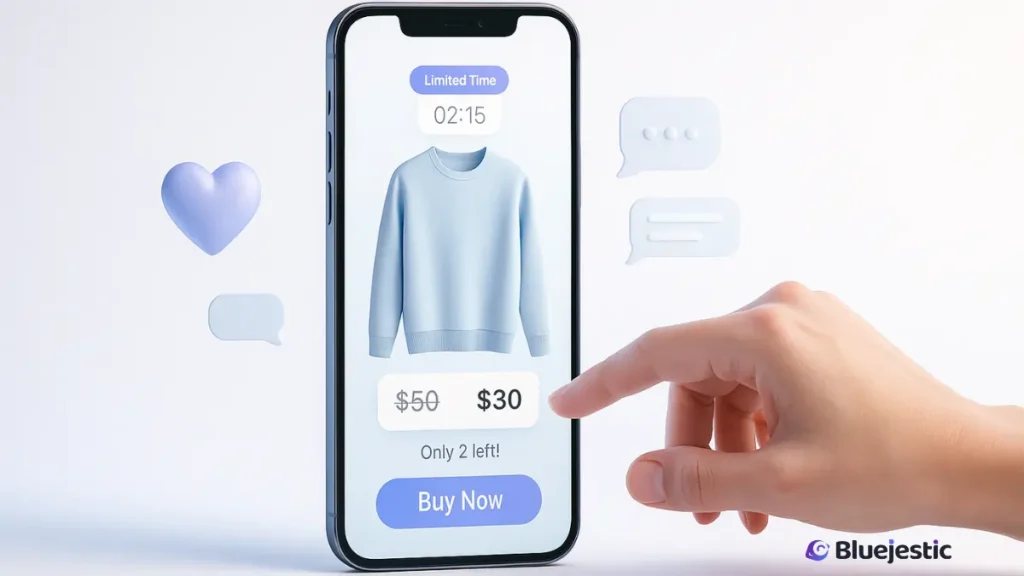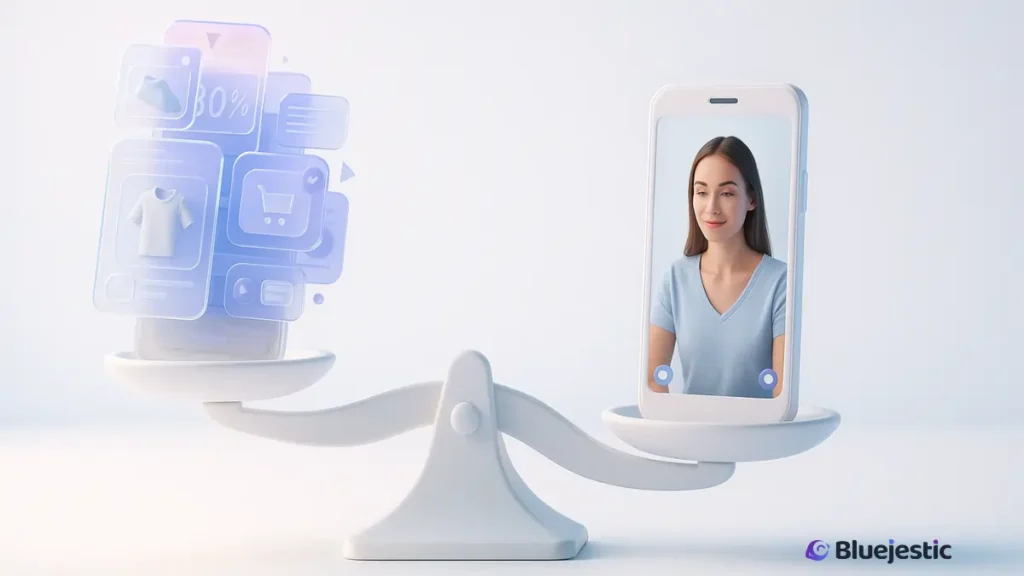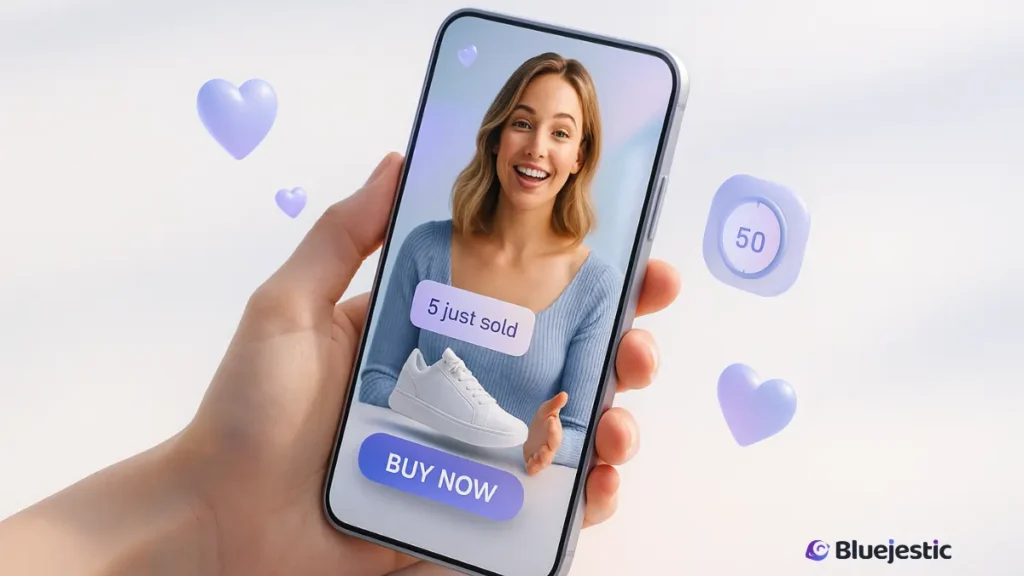Ever wonder why you get so caught up in a livestream shopping event? One second, you’re just watching someone try on sneakers. The next, you’re racing to click “Buy Now” before the deal disappears. You’re not alone. There’s a good reason why live shopping feels so exciting—and why it’s so effective at getting people to shop in the moment.
Live shopping taps into how our brains are wired. It blends entertainment, community, and instant rewards in a way that traditional online shopping just can’t. You’re not just browsing products. You’re watching, reacting, chatting, and being part of a shared moment. It’s like the digital version of going shopping with friends—but with flash sales and countdown timers.
In this article, we’ll break down what’s really happening behind the scenes—in your brain—when you shop live. From dopamine to FOMO to influencer trust, we’ll explore the psychology of live shopping and how brands can use it to create better experiences for shoppers.
Table of Contents
Why Live Shopping Feels So Engaging (and Addictive)

1. The Role of Dopamine & Instant Gratification
Let’s start with brain chemistry. When you see something you like on a live stream and buy it right away, your brain releases dopamine. That’s the same feel-good chemical you get from eating chocolate or getting a like on your post. It rewards you for doing something enjoyable.
Live shopping makes it easy to go from “Ooh, I love that hoodie” to owning it in just a few clicks. That instant reward is a big reason why people love these events. It’s quick, fun, and gives you a rush—kind of like scrolling TikTok or playing games on your phone.
And yes, it can feel a bit like gambling, too. There’s unpredictability. Flash sales pop up without warning. Limited quantities. Will your size sell out? That thrill keeps people watching and clicking.
2. The Power of Social Proof & Herd Mentality
Picture this: you’re watching a live stream and see a message pop up—“Jessica in Houston just bought this.” Then another. And another. Suddenly, you feel like you’re missing out if you don’t grab one, too.
That’s social proof in action. Seeing others make purchases gives us confidence. It tells us, “This must be good if so many people are buying it.” It’s the digital version of a line forming outside a trendy store. Even if you weren’t planning to shop, curiosity (and validation) kicks in.
Things like real-time chat, emoji reactions, and comment floods all play into that herd mentality. They make you feel like you’re part of something exciting. And when you’re in the crowd, it’s easier to follow the crowd.
👉 Read more about how trust plays a role in these decisions in this article on live shopping trust.
3. Fear of Missing Out (FOMO) as a Buying Trigger
Now let’s talk about FOMO—the Fear of Missing Out. Live shopping is practically built on it.
When you see a countdown ticking away or a host saying “Only 2 left!”, your brain shifts into “I can’t miss this” mode. That urgency short-circuits hesitation and drives you to act fast.
FOMO isn’t just about missing a deal. It’s also about missing the moment. If you wait, the livestream ends. The chat disappears. The vibe is gone. That sense of “now or never” makes live shopping irresistible.
Want a deeper dive into this? Check out our post on FOMO in live shopping.
Emotional & Social Factors Driving Live Shopping

4. The Appeal of Community and Belonging
Live shopping isn’t just about the product—it’s about people. Watching a live sale often feels like being part of a shopping party. You see familiar names pop up in the chat. Hosts greet repeat viewers. You react to jokes or outfit changes. It’s surprisingly social.
Humans are wired to want connection. And shopping, for many, has always been a group activity—think of mall trips or browsing markets with friends. Live shopping brings that same vibe into a digital space.
Communities form around favorite hosts, brands, and even product types. And when shoppers feel like they belong, they return again and again.
👉 Learn more about how community shapes the shopping experience here.
5. Parasocial Relationships with Hosts & Influencers
If you’ve ever felt like you “know” an influencer—even though you’ve never met—you’ve experienced a parasocial relationship. It’s a one-sided bond that feels real, and in live shopping, it’s incredibly powerful.
Hosts and influencers chat with viewers, respond to comments, and show their personalities. Over time, viewers build trust and loyalty. And when someone you trust recommends a product? You’re way more likely to buy it.
This connection often beats the effectiveness of a traditional ad. Why? Because it feels personal—not salesy.
👉 Want tips on using influencer-led shopping in your brand strategy? Visit this guide on influencer marketing in live shopping.
6. Shopping as Entertainment (a.k.a. “Shoppertainment”)
Let’s face it—sometimes, we tune in just to be entertained. Live shopping has become a form of content. Hosts crack jokes, tell stories, do quick changes, or challenge viewers with games. It’s a show with products.
The more engaging the host, the more likely viewers stay. And the longer people watch, the more likely they are to buy. Add a bit of humor, music, or behind-the-scenes fun, and suddenly shopping becomes an experience—not a task.
Explore how social media has fueled this shift in our article on social commerce platforms.
Cognitive & Behavioral Triggers in Live Shopping

7. The Scarcity Principle & Perceived Value
Here’s a truth about our brains: when something’s scarce, we want it more. If there’s only 10 available—or worse, just 1 left—it instantly feels more valuable.
Live shopping thrives on this. Hosts often highlight limited stock, one-time-only bundles, or “secret deals” only available during the stream. Even if you weren’t planning to buy, the pressure can sway your decision.
Scarcity triggers urgency. Urgency triggers action. It’s psychology doing the heavy lifting.
8. Anchoring & Price Framing Techniques
Ever see a product listed as “$60, now only $29!”? That’s anchoring at work.
By showing the original price first, then the sale price, brands shape your perception of value. Suddenly, $29 feels like a steal—even if you weren’t looking to spend that much in the first place.
Live shopping adds to this with bundles, limited deals, and exclusive add-ons. When used right, it creates a sense of getting more for less, which boosts conversions.
9. The Power of Micro-Commitments
Good hosts don’t just sell. They guide viewers into small actions first—“Should I try this color next?” or “Tap the heart if you like this look.”
These tiny interactions—likes, comments, reactions—build a sense of involvement. You’ve already interacted, so buying feels like a natural next step.
This is called the micro-commitment effect. Small steps lead to bigger ones. And live shopping is full of these “soft touches” that warm up a viewer to make a purchase.
Challenges in Live Shopping Psychology

10. Decision Fatigue & Overwhelm
Ironically, all that excitement can backfire. If a stream shows too many products, or constantly throws new deals at the viewer, it can get overwhelming. Shoppers tune out or freeze from decision fatigue.
The best live sellers know how to pace their events. They focus on a few key items, mix in breaks, and let the audience breathe. The goal isn’t to flood viewers—it’s to guide them.
11. Trust Issues in Live Shopping
Live shopping is still relatively new in some markets, which means trust is still being built. Some shoppers worry about scams, cheap knock-offs, or influencers pushing products they don’t really use.
To overcome this, brands need to be transparent. Clear return policies, honest demos, and trustworthy hosts go a long way in building credibility.
📌 We cover more about overcoming these hurdles in our guide to live shopping challenges.
How Brands Can Leverage Psychology to Improve Live Shopping Results

12. Creating FOMO Without Pressure
FOMO works—but only when it feels natural. Viewers can sense when urgency is fake, and it turns them off.
The key is balance. Use real-time offers and reminders, but be transparent. Let the audience know they’re getting early access or something limited, without overhyping it.
The best hosts sound excited—but not desperate.
13. Building Long-Term Loyalty Through Emotional Connection
Here’s where live shopping really shines. It’s not just about selling—it’s about relationship-building.
Brands that use the same hosts regularly, tell their stories, and genuinely interact with their viewers see better results. When viewers feel seen and heard, they come back. They trust the brand. They stick around even when they’re not buying.
Live shopping becomes part of their routine—just like their favorite show or podcast.
Frequently Asked Questions (FAQ)
Q1: Why do people buy more during live shopping events?
Because they’re caught up in the moment. FOMO, excitement, and real-time social proof all make it easier to say “yes” without overthinking.
Q2: Is live shopping addictive?
A little, yeah. It activates dopamine in the brain—the same reward system tied to scrolling, gaming, or getting notifications. Add fun hosts and urgent deals, and it’s easy to see why people stick around.
Q3: How can brands use psychology to sell more during live streams?
Focus on emotional connection. Use hosts people trust, offer limited-time deals, and keep the stream engaging with chat, Q&A, and community moments.
Final Thoughts
Live shopping works because it speaks the language of human behavior. From the dopamine rush of a quick buy to the trust we place in familiar faces, every element—emotion, urgency, community—plays a psychological role in why we watch, engage, and ultimately purchase. When brands understand these drivers, they can craft livestreams that don’t just sell, but connect.
At Bluejestic, we believe live commerce should feel less like a pitch—and more like a shared moment. That’s why we equip sellers with the tools to build authentic connections, spark real-time engagement, and turn viewership into loyalty.
Ready to put the psychology of live shopping into practice? Whether you’re a creator, brand, or curious shopper, discover how Bluejestic helps bring your livestream experiences to life—intuitively, intelligently, and impactfully.


